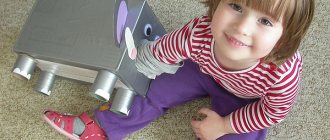Development of fine motor skills in children 4-5 years old
Master class “Development of fine motor skills of hands in children of middle preschool age”
Rasskazenkova Olga Nikolaevna Educator Municipal state-owned preschool educational institution “Kindergarten No. 27” Dear colleagues, today I want to share with you my experience in using didactic games to develop fine motor skills in middle-aged children, which can be done both in kindergarten and Houses.
(Fine motor skills are a set of coordinated actions aimed at accurately performing small movements with the fingers and hands and feet. The nervous, muscular, skeletal and even visual systems take part in this. It includes a variety of movements: from all the usual gestures to the smallest manipulations. ) an important factor in the success of a child’s intellectual and psychophysical development. At all stages of a child's life, hand movements are very important. The most favorable period for the development of a person’s intellectual and creative capabilities is from 3 to 9 years, when the cerebral cortex has not yet been fully formed. It is at this age that it is necessary to develop memory, perception, thinking, attention. (“The origins of children’s abilities and talents are at the tips of their fingers. From the fingers, figuratively speaking, come the finest streams that feed the source of creative thought.” V.A. Sukhomlinsky) The development of fine motor skills is important because the child’s entire future life will require the use precise, coordinated movements of the hands and fingers, which are necessary to dress, draw, write, and also perform a wide variety of everyday and educational activities. The development of manual skill and fine motor skills is also important for the personal development of the child himself. By owning a hand, a child in the process of his development becomes more independent, autonomous and independent from an adult, which contributes to the development of his initiative in various types of children's activities. According to the Federal State Educational Standard for Preschool Education, among the target guidelines at the stage of completing preschool education, it is noted that the child shows initiative and independence in various types of activities - play, communication, the child has developed fine motor skills; he can control and manipulate his movements. A consequence of poor development of fine motor skills of the hand is the general unpreparedness of most children for writing or a problem with speech development. Children with poorly developed manual motor skills awkwardly hold a spoon or pencil, cannot fasten buttons, or lace up shoes. It can be difficult for them to collect scattered parts of the construction set, to work with puzzles, counting sticks, and mosaics. The Federal State Educational Standard for Education tells us that the development of a child should occur in “forms specific to the development of a given age group, primarily in the form of a game,” which is why in my work I use didactic games that allow me to actively develop the fine motor skills of the children in my group. There are many such games, I want to present those that we made together with our parents. Organizational point: we may not know each other well, but I hope we will understand each other, and games will help us with this, we will take them with us. Look what a beautiful bunch of grapes I have, I’ll now tear off one berry from it and tell you my name - my name is Olga Nikolaevna. Pass the bunch on, each “berry” says its name.
Well, here we are. A bunch of grapes consists of different berries, and we are all different. The berries are on a branch together, holding on tightly to it, so we will play games together and exchange work experience. Take the hands of the one sitting next to you, feel the warmth of the hands of your colleagues, who will be your good helpers. With the help of the organizational moment, I create a favorable atmosphere for the upcoming activity, which from the first minutes promises to be exciting, unusual and interesting. I suggest going on a tour of the autumn park. And to keep us warm, we need to put on a coat (hand out coat templates and offer to fasten the buttons). While working, read a poem: the buttons on Verochka’s coat are harmful, the girl’s poor fingers are suffering. The buttons seem to mock Vera, jumping like squirrels, breaking off the threads. Angry tears are rolling down, your brow is frowning sternly, shouldn’t you wear a dress outside in the fall?
With children, you can make playing with buttons exciting, during which you can set various didactic tasks: developing fine motor skills, eye, concentration, perseverance, consolidating knowledge of colors, size, learning to count. One, two, three, four, five - we continue to play, so that our hands do not freeze, we need to warm our hands (game “Hands with elastic bands”). Take two models each and complete the task according to the sample. While working, read the poem: Masha put on her mitten, oh, where am I going? The finger is missing, it’s gone, it didn’t make it to my little house. Masha took off her mitten - hello, little finger, how are you? (play with your fingers). Children love such games very much, they develop thinking, attention, speech, because children can repeat the poem together with the teacher.
My daughter has boots, they are as good as in the picture, but one of all the problems is that my daughter doesn’t like them at all. She doesn’t like laces, they are difficult to deal with (hand out the game “Lacing Shoes”). It’s terrible how much flour it takes to lace up 2 pieces! Slippery, stubborn, mischievous ones. Then the laces came to their senses and were stuck into the holes.
This game can keep your child busy for a long time. What seems so simple and uninteresting to us adults captivates the child and, at the same time, develops his motor skills. This exercise is especially good for training finger coordination. It requires extreme concentration and contributes to the accuracy of the eye. We are dressed and wearing shoes, we can go out for a walk - I suggest collecting a bouquet of leaves for mom (game “Autumn Bouquet”). We will collect birch leaves, rowan leaves, poplar leaves, aspen leaves, oak leaves and take an autumn bouquet to mom. “Autumn Bouquet” is another one of children’s favorite games, with its help we develop fine motor skills, imagination, attention, coordination of movements, speech, and consolidate form. It can be transformed into the games “Which tree is the leaf from”, “Run to the tree”.
We were walking around the park and watching everyone, suddenly, out of nowhere, mice came running (hand out templates, offer to make the mice eyes, nose, ear and braid the tail).
At this time, perform physical. a moment with the jury members. First, let’s warm up our fingers (rubbing the pencil on our palms), exercise “Crane” - we lift the pencil, press it firmly with our finger, “Iron” - I will swing the pencil, from left to right as I want. Such games with a pencil can be played with children while working in notebooks, and recommended to parents for individual work at home. Make paws for your mouse: the mouse was in a hurry to visit and got ready for the journey (your mice ran), the mice stole the cheese, threw a feast in the hole (play with the cheese). Everything is upside down, burrum-burum, gnawing-gnawing-gnawing and crunch, crunch, crunch. There are many variations of this game; it improves coordination between the eyes and hands, and coordination of movements. Weaving influences the development of accuracy, patience, perseverance, the desire to overcome difficulties, to complete the work started, gradually controlling one’s actions. You can take this game with you and play with your children. Our journey into the forest has ended. Look at the sun, stretch out your hands towards it. Its rays, like a mother’s tender hands, warm us with their warmth, we want to laugh, rejoicing at the new day. If you liked everything, and you will use games in your work, I ask you to give a ray of sunshine.
I use this game as a reflection at the end of the activity. You can not only attach rays, but also decorate the rays with ribbons, which contributes to the development of manual dexterity, movements of the hand and fingers, skill, and accuracy. I would like to end our master class with the words of the philosopher Emmanuel Kant - “The hand is a kind of external brain!” This means that at the tips of the fingers there are nerve endings that contribute to the transmission of a huge number of signals to the brain center, and this affects the development of the child as a whole. I will be glad if you use these games in your work. All I can do is thank you for your attention, it was a pleasure working with you. I wish you all creative success.
We recommend watching:
Didactic game for preschoolers to develop fine motor skills Development of fine motor skills using the isothread technique Layouts for kindergarten. Russian folk tales Development of fine motor skills in children of primary preschool age
Similar articles:
Work in a corner of nature in the middle group
Poems for children in the middle group of kindergarten
Thematic Game Day in the middle group of preschool educational institutions
Thematic days in kindergarten in the middle group
Thematic days in the senior group in winter
Card file of exercises and games with goals according to the Federal State Educational Standard
The card file of exercises according to federal standards includes the following types of classes:
- to relax your arms (hands);
- for the development of motor skills using an unsharpened hex pencil;
- for the development of motor skills using natural materials (cones);
- for the development of motor skills with the help of a prickly massage ball.
The first type includes the following exercises:
- "Fish" in the water;
- “Helicopter”, which involves winding thread around an elastic band or ball;
- “Hedgehog” with palms;
- “Hare and Fox” with quickly and slowly “walking” fingers;
- “A conversation between two”, involving interaction between several group members;
- “Flight of the Birds” with active hand work;
- “Track” with buttons sewn to the fabric;
- “Pebbles” with plasticine laid out in a straight line;
- “Watch” aimed at active movements of the hands;
- “Lock”, which includes movements of the fingers and hands;
- “Spider” - moving fingers along the wall;
- “Scissors” with cutting movements of the fingers;
- “Firefighter”, which involves running your fingers along a “ladder”;
- “Peck fingers” - connecting the thumb with the rest in turn.
The second type includes the following exercises:
- “Pencil rolling” using the palm of your hand;
- “Making fire” with rolling a pencil up and down between your hands;
- "Slide" with rolling a pencil up and down one hand using the other hand;
- “Spinner” with a pencil spinning on the table;
- “Helicopter” with a pencil spinning in the air;
- “Crane” with lifting an object with two fingers;
- “Excavator” with lifting a pencil with your finger;
- “Swing” with swinging a pencil with two connected fingers.
The third type includes the following exercises:
- “Twist the bump” using your palms;
- “Roll the bump” using your palms on the table;
- “Catch the cone” by throwing it from hand to hand.
The fourth type includes the following exercises:
- rolling an object back and forth on the table;
- rolling an object around the table in a circle;
- finger pressure;
- catching a thrown ball;
- pressing on the ball with both hands;
- moving the ball from hand to hand with acceleration.
Methods of gender education for preschool children
Finger games and exercises
Finger exercises and games include many variations that require small and large objects of different types and densities. Paper, cereals, bulk and small items are suitable for this.
Important! It is best to accompany lessons with sayings in poetic form. Thanks to this, children will develop their speech apparatus and memory.
Many of the exercises will be useful to the baby in the future (for example, the ability to tie shoelaces, fasten buttons).
Finger drawings
Finger drawings as an element of classes are recommended to be done before lunch. During this period, children are especially active. At first, it is worth conducting a lesson for a couple of minutes, gradually increasing the time to 20 minutes without breaks.
For classes you need to purchase special paints, sold in any store. They have a special consistency that does not require adding water. The lid should fit tightly to the jar.
The sheets you choose should be A3 format so that the child can safely draw and the colors are bright. The presence of “CE” on the box means that the product meets world-class standards.
Massage of palms and fingers
Massage is a key point in the development of children's motor skills. The massage includes stroking the arms from fingers to palms, including the hands. Classes are accompanied by tongue twisters and poems.
Finger massage
Note! Before the massage, you need to warm up the baby's hands. The duration of the procedure should not be more than 5 minutes. Massage should be done for 10 days once a month.
From 1 year: first self-care skills
- Spoon, toothbrush, comb. By the age of one year, they definitely end up in the baby’s hand. They not only allow you to practice self-care skills, but also develop coordination and fine motor skills. By kindergarten we learn how to fasten and unfasten Velcro and buttons on shoes or clothes, and lace up shoes.
- Laces, beads. There are many beautiful lacings in stores, from simple ones (you can try them as early as a year) to complex ones (not earlier than 3 years). You can get by with a piece of cardboard with holes made in it, the main thing is to find a cord with a thick and durable tip or a wooden needle. Beads also don’t have to be bought in the form of ready-made sets - you can cut rings from felt and string them onto ribbons. Such simple and affordable material as dry tube pasta (penne, rigatoni, cannelloni - usually indicated on the package) is also used. It’s good if such activities are daily: they perfectly develop sensorimotor coordination, eye, attention, perseverance, and prepare the hand for writing. They are successfully used as a favorite work material for children in kindergartens working according to the Maria Montessori system.
- Home activities: “knead the dough”, select buttons of different colors and sizes, sort out the cereals, engage in “picking berries” (picking one pea at a time, holding those already collected in the palm of your hand until a full handful), scatter small cereals on a tray and let the child draw on With her finger, lines, objects, letters. Games with clothespins. We pour the cereal - with a spoon, with our hands, in glasses, look for objects hidden in it, and prepare soup for the dolls. We learn to collect water from the table with a sponge and wring out the sponge. We take out small objects from the dish with a spoon (first a table spoon - this is easier - then a tea spoon). Use a spoon to catch small objects from the water. We carry small balls in a spoon around the room. Pour the water into cups (ideally, play in the bathtub while bathing).
- Developmental centers, boards, mats - panels on which hooks, fasteners, locks, buttons, switches, zippers, latches, etc. are attached - for training the accuracy and strength of movements. Also from Maria Montessori's system.





